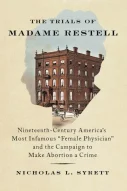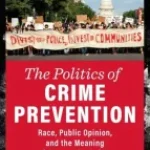The Trials of Madame Restell: Nineteenth-Century America’s Most Infamous Female Physician and the Campaign to Make Abortion a Crime
Author: Nicholas L. Syrett
Publisher: The New Press, 2023. 352 pages.
Reviewer: Karissa Haugeberg | January 2024
Historians have taken issue with a recent spate of biographies that suggest that great people have done great things because they were ahead of or apart from their time. In this new biography of Madame Restell, the professional name that the English-born Ann Trow adopted after she arrived in the United States in 1831, historian Nicholas Syrett reveals how pluck, chance, and success exist in contexts framed by cityscapes, economic booms and busts, and gendered politics. Ann Trow Summers Lohman, who attained infamy as Madame Restell during her lifetime for her lucrative abortion business in New York City, enjoyed a thirty-three-year career, from 1839 to 1872. To understand what set her apart from other women engaged in the illicit abortion trade, Syrett turned to nineteenth-century newspapers, census data, financial records, prescriptive literature, and court documents.
Syrett situates Restell in New York City at a time when anxieties about immigration, industrialization, and changing gender roles made lay reproductive health entrepreneurs—especially successful ones—vulnerable to scrutiny. While women in the rural US had long relied on trusted midwives, recent arrivals to New York City were anxious to find trustworthy reproductive health care providers. Restell and other entrepreneurs understood that they could make a lot of money if they gained women’s trust by providing safe, effective means to end unwanted pregnancies and sustain wanted ones. Restell and other lay providers skirted laws prohibiting abortion and disseminating information about birth control by advertising abortifacients as tools to restore menses.[1] Restell welcomed public attention, buying advertisements in New York newspapers and in dailies across the Eastern Seaboard. Her ads ran alongside stock market prices, shipping news, and real estate ads, giving her bustling contraceptive and abortifacient business an air of legitimacy. By 1839, consumers could purchase Restell’s products at branch offices in Boston and Philadelphia. Ann Lowman and other abortion providers usually adopted pseudonyms to evade the law, but in Restell’s case, to also permit other women to stand in for her, thus expanding her reproductive health empire.
Restell’s career was marked by the expansion of criminal abortion laws. When she began practicing in 1839, early-term abortions had been criminalized in New York for only a decade and few individuals were charged with the misdemeanor crime. However, by the end of her career, lawmakers in New York had followed other states and made abortion at any stage a felony. By 1872, both those who performed abortions and women who sought them could be charged. Moral reformers and district attorneys targeted ‘irregular,’ lay medical practitioners like Restell. She got under their skin for myriad reasons, including by addressing married women directly in her ads and offering them tools to control their own fertility when their university-trained personal physicians would not.[2] Although Restell insisted that her products and services were intended for use only by married women who needed them for ‘health’ reasons, her foes were incensed by the reality that her services offered unmarried women opportunities to assert control over their reproductive lives.
Those who are familiar with the broad contours of Restell’s life will still learn a lot from this book. In addition to providing abortions, Restell, who referred to herself as a ‘female physician,’ also engaged in the crude adoption trade, helped couples who struggled to conceive, offered contraceptive advice, and assisted thousands of women with labor, delivery, and post-partem care. She employed her husband, Charles Lowhman, and her brother, Joseph Trow, to build “a veritable reproductive services empire” in nineteenth-century New York City.[3] Although she was not the only woman in New York who provided abortions, she was certainly the most famous and the most successful. Restell was good at what she did: no client died under her care, a rare feat for any medical practitioner working in the nineteenth century. According to Syrett, Restell’s detractors resented her because she was both “sometimes showy about her success” and because she was a woman.[4] The market for abortions expanded over the course of the nineteenth century, as growing numbers of women sought to control the timing and spacing of their pregnancies.
The relative success of Restell’s reproductive health enterprise during a period of increasing scrutiny makes her a fascinating case study of the illicit marketplaces that thrive in the shadows of moral crusades. The shame, secrecy, and criminality of abortion probably afforded lay abortionists a measure of security: clients had little incentive to testify about their experiences procuring an illegal abortion. She was also shrewd. Her advertisements for abortifacients used innuendo that readers who sought to terminate pregnancy would understand, but that casual readers might dismiss as pertaining to menstrual disorders. Restell preferred to initiate miscarriages in her offices, then send women on their way so that they would experience their deliveries at home. This offered women cover to claim that they had experienced a ‘spontaneous’ miscarriage and made it difficult for investigators to link Restell to the crime. As the laws against abortion hardened, Restell’s luck began to wane. In 1846, Restell performed an abortion on housekeeper Maria Bodine, whose employer-lover arranged the procedure. One year later, a physician determined that Bodine, who had a history of health issues, had received an abortion and alerted New York City’s mayor of the crime. According to Syrett, the salacious trial that followed “made Restell famous” nationally.[5] Restell was found guilty on a misdemeanor charge and served a year at Blackwell’s Island. She became vulnerable to specious lawsuits as her notoriety grew, with some suits lingering in the courts for years.
Although Syrett does not engage historiographical debates about abortion explicitly, he nevertheless dismantles popular myths about the history of antiabortion work. Scholars have described nineteenth-century opponents of abortion as being concerned with controlling women’s sexuality and shoring up physicians’ control over the medical marketplace, especially the sectors that midwives and irregular women physicians controlled. Some argue that antiabortionists’ interests in fetal rights did not emerge until the late 1960s and 1970s, when Catholics and, later, evangelical Christians came to dominate the movement. But Syrett observes that this framing obscures the history of abortion foes who “were quite comfortable likening a fetus to a baby” as early as the 1840s.[6] Vivid cartoons in conservative newspapers depicted Restell and other lay abortion providers holding corpses of infants that they had murdered, likening them to women who abandoned their babies or committed infanticide. This sleight of hand had practical legal consequences. “Thinking about abortion as infanticide,” Syrett explains, “was a way to take it out of the realm of women’s health care, where it had lived for hundreds of years in the United States…and place it in the realm of criminal law.”[7]
Syrett also disrupts the common wisdom that medical men championed antiabortion legislation around the time that they formed the American Medical Association (AMA) in 1847. According to this telling, university-trained physicians sought to wrest control of the lucrative obstetrical marketplace by depicting midwives and irregular physicians as unseemly and dangerous. But Syrett identified physicians who pressed New York legislators nearly twenty years earlier, in 1829, when they helped to craft a law that targeted pharmacists and criminalized the sale of abortifacients. Physicians argued that life began at conception and that only they had the expertise to determine when an abortion was necessary. Both the irregulars who provided abortions and the women who sought them, according to this framing, committed murder when an abortion was performed. Physicians’ disdain for women who sought elective abortions revealed how inattentive they were to the very real dangers of pregnancy and childbirth and for the hard work of parenting multiple children. By 1845, physicians persuaded New York lawmakers to expand the scope of antiabortion laws to include not just the people who performed the procedure, but also the women who sought them. Physicians’ professional interests intersected with moral reformers’ desire to punish married women for limiting their fertility. Both groups shamed single women for having sex outside of wedlock and married women for shirking their motherly duties well before the AMA formally condemned abortion in 1859.
The book’s most engrossing chapter details how the moral reformer Anthony Comstock ultimately toppled Madame Restell’s empire in the 1870s. Comstock’s crusade against obscenity—a capacious category that included everything from pornography to abortifacients—took flight in a series of federal and state statutes that prohibited Americans from sending obscene materials through the mail. In 1878, Comstock himself entrapped Restell by posing as a man who wanted to purchase contraception and abortifacients for a woman. Days later, Comstock returned to arrest her for violating the obscenity acts that he had helped pass only five years earlier. The night before her trial was set to begin, Restell committed suicide.
This book would appeal to undergraduate readers in U.S. gender and sexuality courses, but also to students studying the historian’s craft. I can imagine pairing The Trials of Madame Restell alongside Natalie Zemon Davis’s The Return of Martin Guerre, a classic study of ordinary life in sixteenth-century France, for a unit on thick description. Syrett is straightforward about the messiness of ‘doing’ history: he admits to discovering primary sources that contradicted one another. His hunt for details about Restell’s life sometimes hit dead ends because documents had disappeared from the record. After explaining the vexing work of conducting historical research, Syrett explains how he pieced together a story of about Ann Lohman’s life and work, admitting when well-informed speculation informed his analysis.
I recommend this book to anyone interested in understanding how women experienced the economic, social, and legal changes afoot in nineteenth-century America. Syrett took great care to write with elegant, economical prose. He walks the readers through the sources that he consulted and acknowledges the limits of our ability to know the past. He embedded people, laws, and mores in their time. This fascinating story of Madame Restell, the women she served, and the foes who sought to crush her deserves wide readership.
Karissa Haugeberg is an Associate Professor at Tulane University.
[1] Nicholas L. Syrett, The Trials of Madame Restell: Nineteenth-Century America’s Most Infamous Female Physician and the Campaign to Make Abortion a Crime (New York: The New Press, 2023), 175.
[2] Syrett, 38.
[3] Syrett, 164.
[4] Syrett, 156.
[5] Syrett, 132 and 218.
[6] Syrett, 87.
[7] Syrett, 127.



